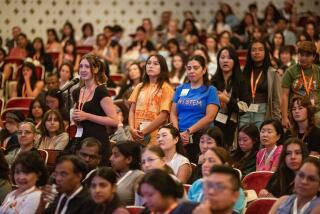Bibles and Beakers Share Space in Student Labs : In Search of the Religion in Science
Bill Woodrome’s junior high school science project is about lasers, powerful light beams that he describes in terms any fellow 14-year-old can understand.
“It’s kind of like a girl when a cute guy walks by,” said Woodrome, an eighth-grader at Leffingwell Christian Junior High in Norwalk. “Girls usually do something weird, like the electrons do. They get excited and expand and let off light,” which creates the laser.
That remark earned Woodrome a pair of rolled eyes from classmate Arika Sanders. “That is so dumb,” she said, tossing her blond ponytail with a giggle.
Although Sanders may dispute Woodrome’s not-so-scientific description of his project, she says he will be a tough competitor when the two go to Biola University on Friday for the annual Assn. of Christian Schools International Science Fair.
Just like those who enter science fair projects in public schools, students in the competition are required to form a hypothesis, research the topic, conduct an experiment and report the results. But at this science fair there is an added requirement: every project must include a verse or analogy from the Bible relating science to God.
“Christ should be considered part of everything we do,” said Woodrome, who was wearing blue acid-wash jeans and had his short hair stylishly slicked back. “Why not a science project?”
When it comes to a cut-and-dried problem such as how lasers work, there is little conflict between the interpretations of science and religion. However, disagreements persist when it comes to that one touchy subject: evolution.
“It’s not that we don’t believe that species change,” said Jerry L. Haddock, regional director of the Assn. of Christian Schools International. “But we don’t believe species change from one to another. We have not seen any scientific evidence to prove that it does.”
Students from 14 Southeast Los Angeles County Christian schools are entered in the science fair, which will include more than 350 entries from 57 junior high and high schools in Southern California. This is the 10th year of the fair and the first time it is being held at Biola, a Christian college in La Mirada, said Haddock.
A panel of 30 science instructors and students from Biola will judge the students’ work on a 50-point scale, with 15 points for scientific method, 10 for originality and creativity, 10 for knowledge achieved, 10 for clarity and 5 for biblical application.
“We want them to realize that all science is created by God,” Haddock said. “We do not need to discredit belief in God from our belief in science. We feel like the two support each other.”
Haddock said science fair officials would not be opposed to any kind of experiment, including one on evolution, because “anything that would be proven would prove God’s word.”
This will be the second year Sanders and Woodrome have competed in the fair. They are representing Leffingwell after placing first and second, respectively, in the school’s science project competition earlier this year.
Woodrome was going to use the “Let there be light” Scripture from Genesis for his laser project, but decided that was too obvious. “I’m trying to find a better one,” he said.
The Scripture worked fine for Sanders, whose project on how light behaves won first place in Leffingwell’s own science fair earlier this year. The 14-year-old says she wants to be a dance teacher. “Science is my least favorite subject,” she said.
But 10 years of dance and gymnastics contests have instilled a competitive spirit in Sanders, who is confident she will win top honors at this year’s science fair. “I like to win,” she said.
“Last year it was a little difficult because we didn’t know what other people were going to do,” she said. “This year, I have a little more confidence” because the competition is more familiar.
Sanders started working on her project before Christmas vacation, taking about a month to write a report on refraction, diffraction and reflection of light. She then illustrated the information on a 2-by-3-foot board, showing how a rainbow is formed and how panes of glass can separate light.
Both Woodrome and Sanders say their science education has not suffered because of attending a smaller school, although Woodrome said he is considering attending Bellflower High School next year “because they have a bigger science department.”
But, they said, the public schools do not reconcile science and religion, particularly when it comes to evolution.
“If (evolution) is true, then why aren’t there apes turning into people now?” Woodrome asked.
Despite his skepticism about some scientific theories, Woodrome says he wants to study the subject at the university level.
“I figure I’ll be about 42 when I get out of college, with all the bachelor’s degrees I want to get,” he said, pointing out that he wants to earn diplomas in math, science and related areas, at the very least.
Not Sanders. She wants to pursue a career in dance, and plans to attend Leffingwell Christian High School next year. “I have never gone to public school and I don’t want to,” she said.





